List of Authors
>>About this blog
Recent blog post
|
[Dimini ☆ Cricket]
August 31, 2016 18:00
Just a year ago, I wanted to get useful information about Shell Tea  (Shetland Seap Dog, 3, 1 year old), which became a member of my home, such as how to raise, discipline, prevention of illness, etc. Then, I knew that an organization called Japan Colli Club was in Chuo-ku, visited immediately, received explanations, and joined. (Shetland Seap Dog, 3, 1 year old), which became a member of my home, such as how to raise, discipline, prevention of illness, etc. Then, I knew that an organization called Japan Colli Club was in Chuo-ku, visited immediately, received explanations, and joined.

The Japan Colli Club (J.C.C.) is located on the 8th floor of Ginza Wakaho Building, a little southwest of Harumi-dori St., opposite Kabukiza Theater. My address is Ginza 5-chome 14-8.
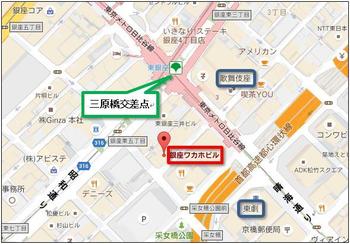
The Japan Cory Club aims to improve and proliferate and spread the cory dog breeds (Rafcory, Smooth Cory, Shetland Seapdog, Border Cory) as sheep dogs and family dogs, and to promote mutual friendship among members.
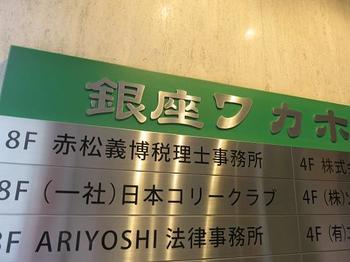
This club was founded in 1953 (Showa 28), and in 2012, it was a club with a history that held a celebration of the 60th anniversary of its founding. and in 2012, it was a club with a history that held a celebration of the 60th anniversary of its founding.
The photo below  shows the lineage testimony issued by j.c.c.c. shows the lineage testimony issued by j.c.c.c.
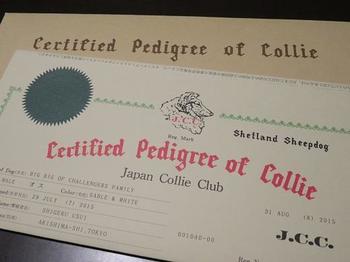
Anyone who breeds a collie dog breed or who loves a collie dog breed even if they do not currently have a collie dog breed can join.
 The photo below shows the textbook, rules and standards, and guidance D.V.D issued by j.c.c. The photo below shows the textbook, rules and standards, and guidance D.V.D issued by j.c.c.
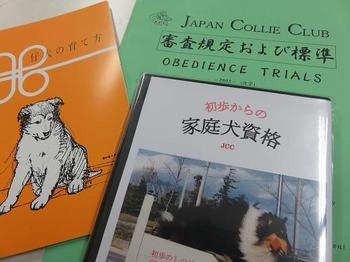
If you join, you can register a puppy and participate in events organized by Colli Club Books and Branchs.
You will  also receive a newsletter "Kory Fancy" issued once every two months (full of information and photos about Collie and Shell Tea also receive a newsletter "Kory Fancy" issued once every two months (full of information and photos about Collie and Shell Tea ) )

I have just joined, but I would like to actively participate in club-sponsored events and support  the happy life (dog life the happy life (dog life ) of my dog. ) of my dog.

The information and materials introduced on this blog were provided by the Japan Colli Club Public Relations Department. Thank you very much
Click here for the website of J.C.C. Japan Collie Club ⇒
http://www.collieclub.jp/index.htm
     
[rosemary sea]
August 31, 2016 14:00
This is rosemary sea, which covers "gifts and enjoy yourself" as the backbone.
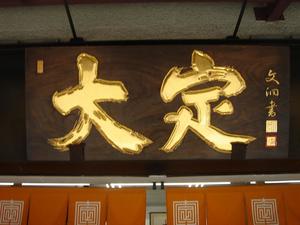 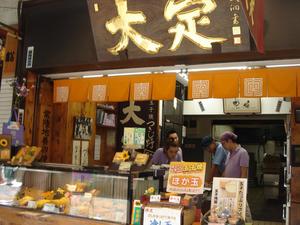
Before I became a correspondent, I visited Daisada, who sells delicious egg ware at Tsukiji Outer Market.
I thank Mr. Ishii for your help.
Daisada was founded in 1924 and is a long-established store with a history of 92 years this year.
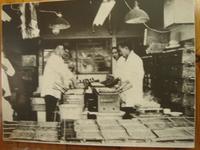
Daisada's egg ware is ...
〇 Uses 100% carefully selected red egg called "ground egg" from Chiba Prefecture.
Grounded egg is a sap of oak tree = egg produced by chickens grown on food containing ground nutrients such as wood vinegar, cashmerate, wormwood, and seagrass.
It is said that only Chinese medicine's special feed is given, so it is said that cholesterol is 10% less than usual eggs and less involved in allergies. It is made with fresh, safe and excellent eggs, so the taste of egg ware changes greatly. About 15 years ago, the president chose an egg that matches egg ware from the crow chickens and many brands of eggs. The name of "Tsukijino" was also around that time. It is the president's idea to differentiate itself from other stores, not just egg ware.
〇 In addition, everything is hand-burned.
Skilled craftsmen make reliable egg ware with all their heart.
From a poultry farm in Chiba Prefecture, fresh and well-managed eggs are delivered in the middle of the night, prepared at 4:00 am, and started baking around 5:00.
〇 Mixed egg with dashi soup, soy sauce, sugar and salt. However, the method of blending and ratio are secrets.
〇 The basic size is fixed.
For example, in the case of the mainstay and standard product "Tsukijino", the basic size is 560g, the size is 19 x 10 x 3.5 (cm).
Next, the main product lineup. From the top ...
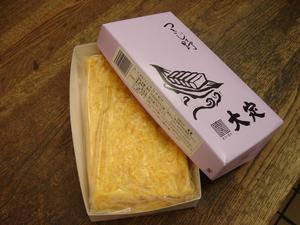 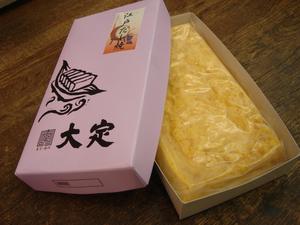 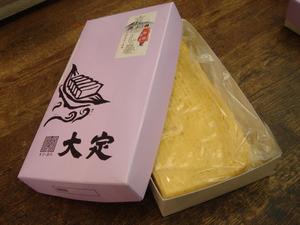 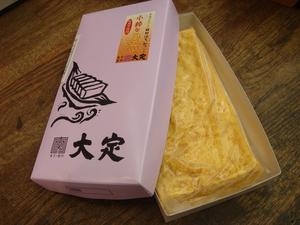 
No.
It's also for sushi restaurants, and it feels solid. It's less sweet than those from other stores.
Edo dashiyaki.
The sweetness is further reduced by adding more dashi. The texture is soft.
Kyoto dashimaki.
The dashi is completely different. Kyoto-style dashi with bonito. The texture is also quite soft.
A smart honey.
No sugar. Only domestic honey and apple vinegar are carefully selected.
Egg ware with a subtle sweetness that is gentle to the body.
Shinko Meitaiko.
New products from July. This product is popular with overseas people, especially Chinese people.
It is said that the number of tourists and foreign visitors has increased.
Some people say "no fish" or present a mobile screen or description.
If you give instructions, it seems that it is recommended to remove the dashi roll (use of bonito).
One rosmariepisode.
Visited the store on December 30, last year. There was a very long line, so I asked the guide clerk, "How long does it take?" When asked, he answered, "It's about 10 minutes." When I lined up, I was able to buy it in 10 minutes. I was surprised and impressed by the skill of the people in the shop. ・・ ・ I bought Tsukijino.
The taste period is 5 to 6 days. If you want to eat it immediately, you can also give a gift.
Notice
On September 15th, "Exciting Tour / Tsukiji Outer Market Course Part 1", I and Rosmari will also join the guidance, but Mr. Daisada, I will visit you.
4-13-11, Tsuiji 03-3541-6964
Business hours from 4:00 to 14:30 (only on Saturday until 15:00)
Sunday Holidays We are wandering on the market street, so we will be closed when the market is closed.
Enter from the "Ichiba Bridge" signal intersection at the corner of the National Cancer Center Central Hospital, and in the middle of the entrance to the hall, on the left.
Click here for Daisada's website ⇒ http://www.daisada.jp/
(The small photo in the center shows the production at the time of its founding. At that time, I only baked sushi balls.
[Yuyama also only]
August 31, 2016 12:00
I went to the East Theater, which is being screened at the MET Opera Live Viewing Encore. It's a good chance to see what you missed in the past season. Since 2006, seasonal metropolitan operas can be viewed at a low price at movie theaters, so opera fans around the world can enjoy it.
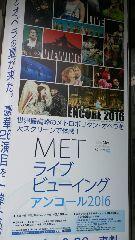 It's very popular. You can enjoy a live screening at the movie theater. A little disappointing is that when you go to the Opera, you can see the singer's skills in hand, but since it passes through the sound source, the volume is adjusted, so anyone can listen well and the same amount of voice I wonder if there is. It's very popular. You can enjoy a live screening at the movie theater. A little disappointing is that when you go to the Opera, you can see the singer's skills in hand, but since it passes through the sound source, the volume is adjusted, so anyone can listen well and the same amount of voice I wonder if there is.
Higashi  drama is operated by Shochiku, so it is famous for the screening of "Tsuki 1 Kabuki". drama is operated by Shochiku, so it is famous for the screening of "Tsuki 1 Kabuki".
We are aiming to replay Bize's "Pearl Picking" and Puccini's "Manon Lesko", which were missed in the 2015-16 season. In addition, there is a discount of 500 from the season screening.
"Manon" 10:30 Screening → I've taken out some time. I feel like I went to the New York Metropolitan Opera House.
The interviewer Deborah Boito is now available. `I saw it before,' !!
"Manon" is different.
The opera performance time is long, so I don't have time to watch the second show. It was "Manon Lesko" that I wanted from three p.m.
I've been watching it for 10 years since 2006, but I've been away from watching the opera for a while, and I made a basic mistake.
Well, I'm going to see the combination of Netrepco & Pechawa again! ?
I will never make a mistake next time.
I wanted to see an Italian opera, not a French opera.
It was a great mistake, but I enjoyed watching it.
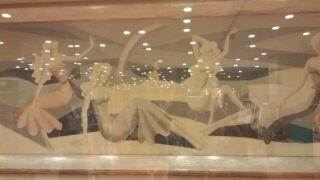 When I left the drama, I found a picture of Seiji Togo and was even more happy to see Mont Blanc in Jiyugaoka, who has been familiar with since childhood. . When I left the drama, I found a picture of Seiji Togo and was even more happy to see Mont Blanc in Jiyugaoka, who has been familiar with since childhood. .
See you again.
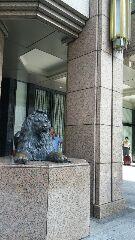 The other day, after the tour of the Japan Industrial Club Hall, I stopped by at Ginza Mitsukoshi to send Western sweets to an acquaintance. The other day, after the tour of the Japan Industrial Club Hall, I stopped by at Ginza Mitsukoshi to send Western sweets to an acquaintance.
There was a lion in the store number, but the shutter was closed.
I'm surprised! Chinese tourists are also disappointed!
From Mitsukoshi, go to Ginza TOKYU PLAZA.
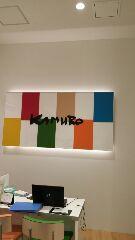 Although it is different from the famous Ginza 100-year store, I stopped by my favorite "KAMURO". It's an eyeglass store. Recently, I've been getting sick, so I decided to make something new. Although it is different from the famous Ginza 100-year store, I stopped by my favorite "KAMURO". It's an eyeglass store. Recently, I've been getting sick, so I decided to make something new.
If you draw a "lottery" here, you won the 2nd prize! I'm lucky to have a little discount!
The glasses will be ready at a later date. I'm looking forward to it.
Misunderstands and misfortunes are likely to end with lucky chances and fall.
[Chuo Kotaro]
August 31, 2016 09:00
I had the opportunity to guide Tsukiji in mid-August, and I studied Tsukiji again in about a month.
I was reminded that it was an interesting place.
If you classify the charm of Tsukiji, I think it will be categorized below.
①History of Tsukiji (1) Within and outside Tsukiji Markets
②History of Tsukiji (2) Landfill and Honganji
③History of Tsukiji (3) Foreign Settlements
④Building heritage
⑤A treasure trove of gourmet
④⑤If you understand it in relation to the history and location of 1-3, I think it will become even more attractive.
This time, I would like to focus on "4 architectural heritage" from the charm of Tsukiji.
I think.
I think the architectural heritage of Tsukiji can be classified as follows.
A. The streets of the early Showa period (Machiya group, signboard architecture, alley)
B. Temple
C. The remnants of foreign settlements
D. Fan-type Tsukiji Market
Of these, the old townhouses, signboard architecture, and some temples in B are the World Monument Foundation.
The U.S. non-profit organization has been selected as a list of crisis heritages to be announced once every two years.
It is a world-famous substitute for Historic buildings.
Below is a map of the distribution of architectural heritage.
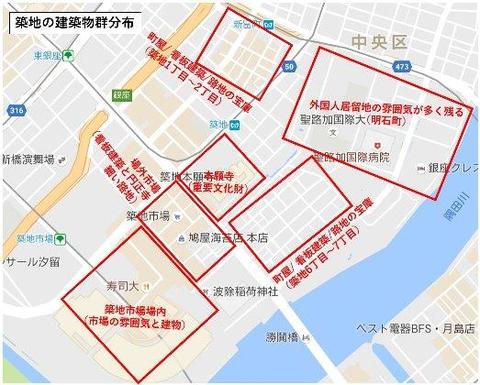
◆◆Distribution of architectural heritage around Tsukiji◆◆
A. The streets of the early Showa period (Machiya group, signboard architecture, alley)
Machiya, signboard architecture, and alleys are the part of Tsukiji 1-chome and 2-chome near Shintomi-cho.
It is often found in the area from Tsukiji 6-chome to 7-chome.
Personally, I like the neighborhood of 6-chome, which leaves a rich Showa atmosphere in a wide area.
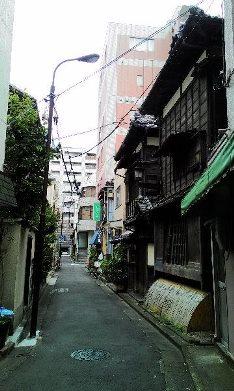 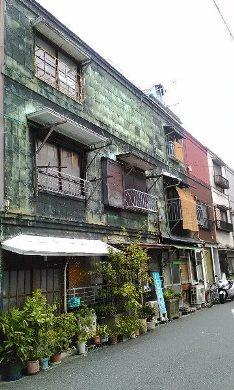
<Alley of Tsukiji 2-chome, signboard construction of Tsukiji 6-chome (copperboard)>
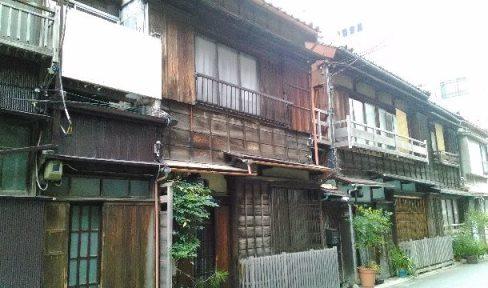
<Machiya of Tsukiji 6-chome>
On the other hand, out-of-market markets tend to be overlooked due to congestion and the eaves of stores.
If you look up, you will notice that there are many signboard architectures.
In addition, there is a very narrow alley connecting Higashi-dori, Naka-dori and Nishi-dori on the main street.
There are many shops on both sides of the alley, so "Eh? There's a shop like this."
You can meet a fresh surprise.
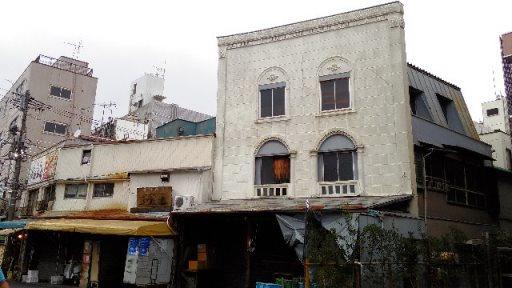 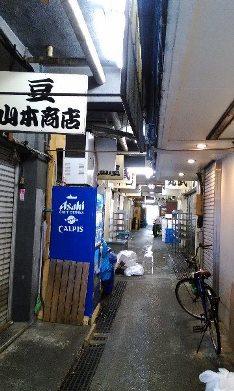
<Signboard construction (mortar) outside the hall, alleyway through outside the hall>
By the way, "signboard construction" means that a wooden building is surrounded by copper plate or mortar to prevent fire resistance.
It is a raised building and is classified into "copper plate type" and "mortar type" according to the material of the enclosure.
We were able to apply various designs such as patterns on copper plates and mortars like signboards.
It seems to be called "signboard architecture".
I hope these streets will remain forever.
B. Temple
I can't touch it here because it's too commonplace for Tsukiji Honganji.
Outside the hall was originally the Terauchi town of Honganji, where many temples are lined up neatly and densely.
I was there.
Most of them were relocated after the Great Kanto Earthquake, and now only a few remain.
In terms of historical buildings, I don't think "Enshoji" in this cannot be removed.
The side of Enshoji is integrated with stores in the out-of-store market, and it is like a fusion of signboard architecture and temples.
It has a rare landscape that can not be seen anywhere else, and I think it is a must-see.
(I want this landscape to remain.)
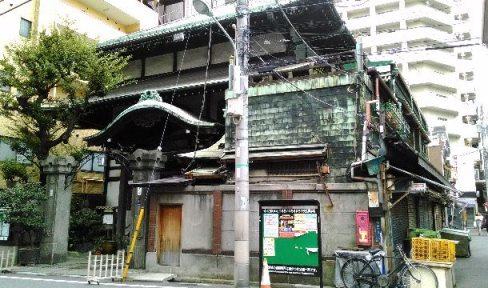
<Enshoji Temple (on the right side is integrated with the store)>
C. The remnants of foreign settlements
I think that foreign settlements are from now around Harumi-dori St. to around Irifune.
It looks good, but the center is around Akashicho.
As for buildings, the Toysler Memorial Hall and Catholic Tsukiji Association have remained since that time.
It's left.
There is also the St. Luke Chapel, gas lights remain, and the area is green and Western-style.
I think you can feel the atmosphere.
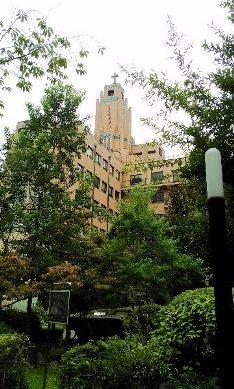 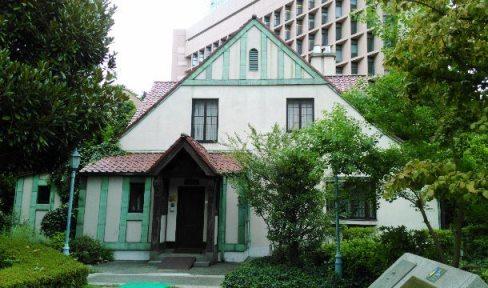
<St. Luke Chapel, Toysler Memorial Hall>
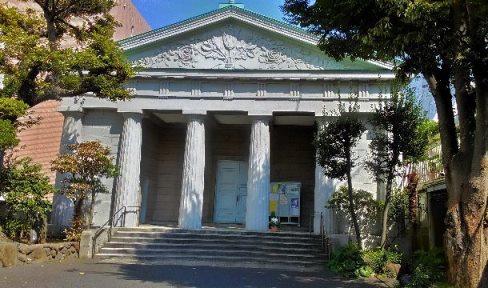
<Tsukiji Catholic Church>
D. Fan-type Tsukiji Market
The building of the fan-shaped Tsukiji Market itself, the sales floor of wholesalers in the hall, and the fish riverside Yokocho.
The atmosphere of the building and the vibrant market is also one of the attractive buildings for me.
However, this will be gone after the relocation to Toyosu, so go now.
Let's keep it.
Then I will add one point.
Tsukiji is almost reclaimed now, but originally there is a waterway around the Tsukiji River.
It is a stretched land, and there are many places where the site is a green road, and the greenery is rich.
Especially in the area around St. Luke's International Hospital, it feels good to walk. Old maps and contemporary maps,
In addition, it is fun to take a walk around the area while comparing the photos of the time.
This time, I introduced Tsukiji from the viewpoint of architectural heritage.
If I have the opportunity, I would like to write an article from the viewpoint of gourmet.
History, architecture and gourmet. The market will move, but even so Tsukiji will create a charm that won't get bored.
It's overflowing.
[The Rabbit of Tsukuda]
August 30, 2016 18:00
The Indian spot-billed duck and others seen on the Sumida River Terrace in Ishikawajima Park have a total of 5 birds, 2 pairs and singles. It is not clear whether everyone has a bed on the floating island at the base of Aioi Bridge. That's because Mr. Indian spot-billed duck is dead. Today, we will deliver the daily lives of Indian spot-billed duck with the summer of Ishikawajima Park.
The red color of common sage, the flower bed in Ishikawajima Park, shines as blue on the river surface.

When the clover in Paris became white all over, Mrs. Indian spot-billed duck often took a walk if he liked it.
 
If you are tired after taking a walk, take a break in the shade of cherry blossoms.
After all, Mr. Indian spot-billed duck also likes the bright scenery.
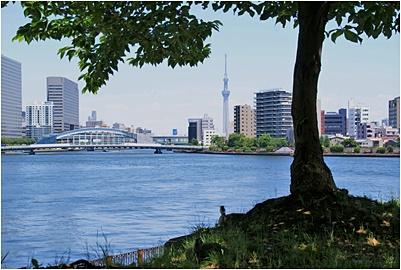
Oh!!‼

Everybody doing gymnastics every day on the opposite bank at 6:30 in the morning.
Mr. grey heron is aiming for an opportunity for breakfast, but Mr. Indian spot-billed duck is still in bed dexterity.

With a good position as the runner in the morning passes, Mr. Indian spot-billed duck has nothing to spare.
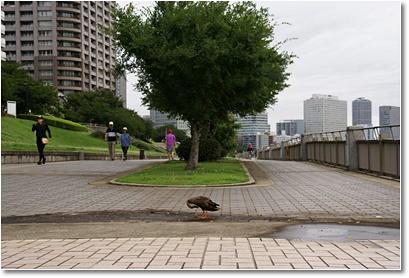 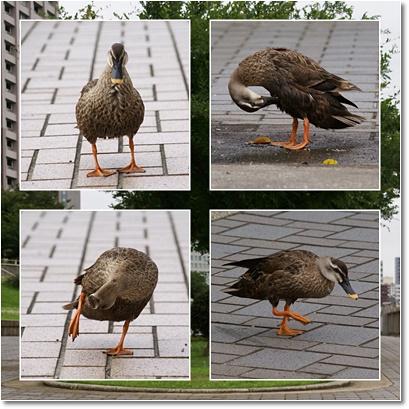
I don't get along with dogs, but if I keep a distance, coexistence is okay.
Well, the day is starting today.
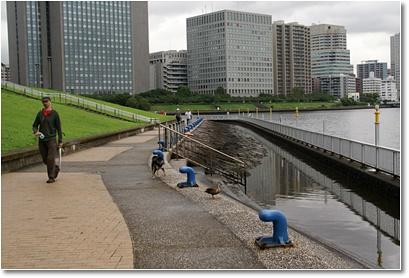
I would like to continue watching Mr. Indian spot-billed duck and others.
[Silver]
August 30, 2016 16:00
A board installed on the outer wall of Nomura Securities in Nihonbashi. As early as possible, the number of days of countdown for the Tokyo 2020 Olympic and Paralympic Games is displayed.
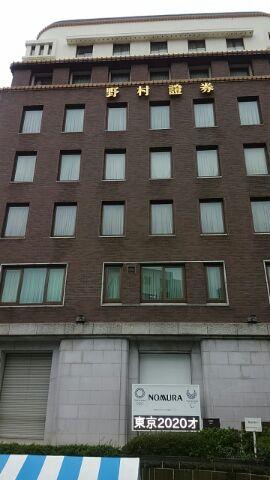 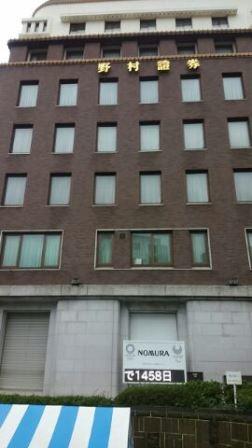
The activities of the Japanese team, such as judo, swimming, gymnastics, wrestling, table tennis, and relay, played an active part in Rio 2016, are still clear in my memory. In addition, we can expect the success of the Paralympic athletes.
After that, about 1,400 days, I am dreaming of becoming a better Tokyo Olympics and Paralympics with the growth of young players.
I aim to be a volunteer guide for better hospitality by brushing up English and Portuguese. Let's do our best, Japan!
|
Links
|
![]() (Shetland Seap Dog, 3, 1 year old), which became a member of my home, such as how to raise, discipline, prevention of illness, etc. Then, I knew that an organization called Japan Colli Club was in Chuo-ku, visited immediately, received explanations, and joined.
(Shetland Seap Dog, 3, 1 year old), which became a member of my home, such as how to raise, discipline, prevention of illness, etc. Then, I knew that an organization called Japan Colli Club was in Chuo-ku, visited immediately, received explanations, and joined.![]()
![]()
![]()
![]() and in 2012, it was a club with a history that held a celebration of the 60th anniversary of its founding.
and in 2012, it was a club with a history that held a celebration of the 60th anniversary of its founding.![]()
![]() shows the lineage testimony issued by j.c.c.c.
shows the lineage testimony issued by j.c.c.c.![]()
![]()
![]() The photo below shows the textbook, rules and standards, and guidance D.V.D issued by j.c.c.
The photo below shows the textbook, rules and standards, and guidance D.V.D issued by j.c.c.![]()
![]()
![]() also receive a newsletter "Kory Fancy" issued once every two months (full of information and photos about Collie and Shell Tea
also receive a newsletter "Kory Fancy" issued once every two months (full of information and photos about Collie and Shell Tea![]() )
)![]()
![]() the happy life (dog life
the happy life (dog life![]() ) of my dog.
) of my dog.![]()
![]()
![]()
![]()
![]()
![]()
![]()
![]()















 It's very popular. You can enjoy a live screening at the movie theater. A little disappointing is that when you go to the Opera, you can see the singer's skills in hand, but since it passes through the sound source, the volume is adjusted, so anyone can listen well and the same amount of voice I wonder if there is.
It's very popular. You can enjoy a live screening at the movie theater. A little disappointing is that when you go to the Opera, you can see the singer's skills in hand, but since it passes through the sound source, the volume is adjusted, so anyone can listen well and the same amount of voice I wonder if there is. drama is operated by Shochiku, so it is famous for the screening of "Tsuki 1 Kabuki".
drama is operated by Shochiku, so it is famous for the screening of "Tsuki 1 Kabuki". When I left the drama, I found a picture of Seiji Togo and was even more happy to see Mont Blanc in Jiyugaoka, who has been familiar with since childhood. .
When I left the drama, I found a picture of Seiji Togo and was even more happy to see Mont Blanc in Jiyugaoka, who has been familiar with since childhood. . The other day, after the tour of the Japan Industrial Club Hall, I stopped by at Ginza Mitsukoshi to send Western sweets to an acquaintance.
The other day, after the tour of the Japan Industrial Club Hall, I stopped by at Ginza Mitsukoshi to send Western sweets to an acquaintance. Although it is different from the famous Ginza 100-year store, I stopped by my favorite "KAMURO". It's an eyeglass store. Recently, I've been getting sick, so I decided to make something new.
Although it is different from the famous Ginza 100-year store, I stopped by my favorite "KAMURO". It's an eyeglass store. Recently, I've been getting sick, so I decided to make something new.





















